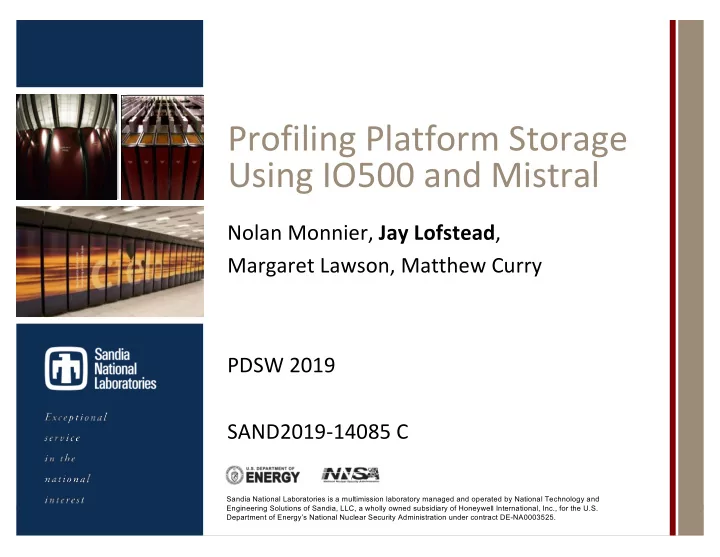

Profiling Platform Storage Using IO500 and Mistral Nolan Monnier, Jay Lofstead , Margaret Lawson, Matthew Curry PDSW 2019 SAND2019-14085 C Sandia National Laboratories is a multimission laboratory managed and operated by National Technology and Engineering Solutions of Sandia, LLC, a wholly owned subsidiary of Honeywell International, Inc., for the U.S. Department of Energy’s National Nuclear Security Administration under contract DE-NA0003525.
Astra Testbed Prove viability of advanced technologies for NNSA integrated codes, at § scale Expand the HPC-ecosystem by developing emerging yet-to-be proven § technologies Is technology viable for future ATS/CTS platforms supporting ASC mission? § Increase technology AND integrator choices § Buy down risk and increase technology and vendor choices for future § NNSA production platforms Ability to accept higher risk allows for more/faster technology § advancement Lowers/eliminates mission risk and significantly reduces investment § Jointly address hardware and software technologies § First Prototype platform targeting Arm Architecture § #156 on top500 (June 2019) (2.2 PF) § 2
Astra Hardware 3
Astra System Specs 2,592 HPE Apollo 70 compute nodes Bandwidth: 885 TB/s § Cavium Thunder-X2 Arm SoC, 28 core, 2.0 Mellanox IB EDR, ConnectX-5 § § GHz HPE Apollo 4520 All–flash storage, Lustre § 5,184 CPUs, 145,152 cores, 2.3 PFLOPs parallel file-system § system peak Capacity: 403 TB (usable) § 128GB DDR Memory per node (8 memory § Bandwidth 244 GB/s § channels per socket) Aggregate capacity: 332 TB, Aggregate § 8 GB DDR4-2666 DR 8 GB DDR4-2666 DR 8 GB DDR4-2666 DR 8 GB DDR4-2666 DR 8 GB DDR4-2666 DR 8 GB DDR4-2666 DR Cavium Thunder-X2 Cavium Thunder-X2 8 GB DDR4-2666 DR 8 GB DDR4-2666 DR ARM v8.1 ARM v8.1 8 GB DDR4-2666 DR 8 GB DDR4-2666 DR 28 cores @ 2.0 GHz 28 cores @ 2.0 GHz 8 GB DDR4-2666 DR 8 GB DDR4-2666 DR 8 GB DDR4-2666 DR 8 GB DDR4-2666 DR x8 x8 8 GB DDR4-2666 DR 8 GB DDR4-2666 DR Mellanox ConnectX-5 OCP Network Interface 4 1 EDR link, 100 Gbps
Astra Storage Specs § /lustre filesystem § 40 OSSes § 2 MDSes § 21 1.6TB NVMe devices per OSS spread across 3 ZFS pools per node using raidz § 240 GB/sec peak bandwidth § 990 TB usable storage § /oscratch filesystem § 8 OSSes, each serving 10 OSTs § 2 MDSes, 1 MDT each § Storage has full bandwidth to interconnect core (4xEDR 100 Gpbs Infiniband) 5
§ Virtual Institute for IO (https://www.vi4io.org) hosted § http://io500.org § Collect details information about storage and platforms § Provide a balanced way to compare storage systems § No, it is not perfect § MDTest, IOR, and find § “hard” tests for worst case scenarios § “easy” tests user configurable to showcase a system’s potential § Find to represent walking the file tree for purge or similar § Geometric mean of all values to get resulting score § Published at ISC and SC every year (Tuesday, 12:15, 205-207) 6
Profiling IO § Darshan is available, but we wanted to see how this Ellexus’ Mistral tool worked and then compare § Future work § Mistral offers node-level statistics § Breeze is the per process tool § Collect on a per-second basis § Ideal configuration is Elasticsearch and Grafana § How well is our ARM-based Lustre client and the back end Lustre system working? § Can we learn using IO500’s setup instead of apps or app proxies? 7
Tuning IO500 to Push the System 1) Obtain system information and theoretical characteris- tics. 2) Set test directories’ stripe size based on test files’ size and number of storage targets. 3) Determine number of nodes to use. 4) Increase the cores per node to maximize bandwidth, until the bandwidth for ior easy reasonably approaches a theoretical limit. 5) Adjust the cores per node to balance bandwidth and metadata results 8
Tuning Final Configuration § Configured striping to best suit the ”hard” tests § Set nodes used == to number of storage targets § /lustre used 58 procs (on the 58 cores) on 121 nodes § 10 node challenge ran proportional configurations § Metadata did not require special stripe configurations 9
Scores Nodes Mount Point Bandwidth IOPS Score 121 /lustre 84.8118 GB/s 35.9847 kiops 55.2443 10 /lustre 28.4097 GB/s 45.7227 kiops 36.0412 § 14 th on the ISC19 overall list § 13 th on the ISC19 10 node challenge § Plug: (see new results at IO500 BoF Tuesday 12:15, 205-207) 10
Problems! § On /oscratch filesystem, we ran out of space in directory when creating files § Lustre has an option to extend capacity, but we were not allowed to change it. § This prevented getting “official” /oscratch results 11
IOR Write Easy 12
IOR Read Easy 13
IOR Write Hard 14
MD Stat Easy 15
MD Stat Easy 16
MD Stat Hard 17
MD Read Hard 18
MD Write Easy 19
Conclusion § Hit 33% of peak (midpoint of 20%-50% of peak expected) § Reproducibly issues with the Lustre client and MPI we had not isolated before § Found gradual performance degradations and odd performance fluxuations to debug 20
Acknowledgements § Thank you to Ellexus for supporting this work § Supported under the Vanguard project from NNSA § Sandia National Laboratories is a multimission laboratory managed and operated by National Technology and Engineer- ing Solutions of Sandia, LLC, a wholly owned subsidiary of Honeywell International, Inc., for the U.S. Department of Energys National Nuclear Security Administration under contract DE-NA0003525. 21
Recommend
More recommend